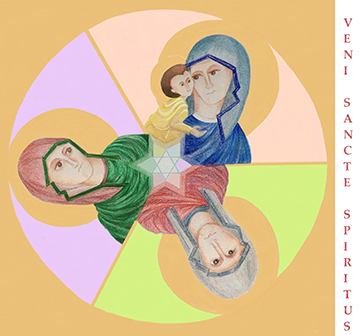Confirmation May 25, 1806, Elizabeth Ann Seton wrote to Antonio Filicchi that receiving the sacrament had “added the name Mary to the Ann Elizabeth which present the three most endearing ideas in the world — and contain the moments of the Mysteries of Salvation.” (Collected Writings [CW] 1:408)
 An icon is a “Window into Heaven” revealing God’s mysteries. It depicts the history of salvation, and its manifestation through concrete persons. When viewing an icon, one becomes a part of the mystery. Elizabeth Seton’s words: “… contain the moments of the Mysteries of Salvation” aptly capture the essence of an icon, moreover, her “trinity” of women.
An icon is a “Window into Heaven” revealing God’s mysteries. It depicts the history of salvation, and its manifestation through concrete persons. When viewing an icon, one becomes a part of the mystery. Elizabeth Seton’s words: “… contain the moments of the Mysteries of Salvation” aptly capture the essence of an icon, moreover, her “trinity” of women.
The icons are placed in a mandala, a circular design, indicating that everything is connected, complete in itself. St. Anne traditionally wears green (symbolizing hope, life, nature’s eternal renovation). St. Elizabeth is dressed in red (humanity’s life-giving energy), and Mary in blue (showing her heavenly nature) holds Christ. Gold is reserved for Christ. The Star of David holds the central root.
Three women —blood-related— maintain a remarkable legacy. Each was a daughter, wife, mother, saint, Jewish, and is honored in Islam. Churches and institutions world-wide take their names. They intercede on behalf of the expectant mother, the death of a child, the widow, and persons who are homeless, to name a few. Mary alone bears over 50 titles as model and patron.
Elizabeth, confirmed on Pentecost, followed her courageous and kindred sisters in faith. Filled with the Holy Spirit, “God has shown them his grace” (Luke 1:30). Salvation history now presents us with yet another most endearing idea in the world: St. Elizabeth Ann Seton.
– Catherine Salani (SC Collaborator, Educator, Artist)

Thank you, Catherine, for your reflection.